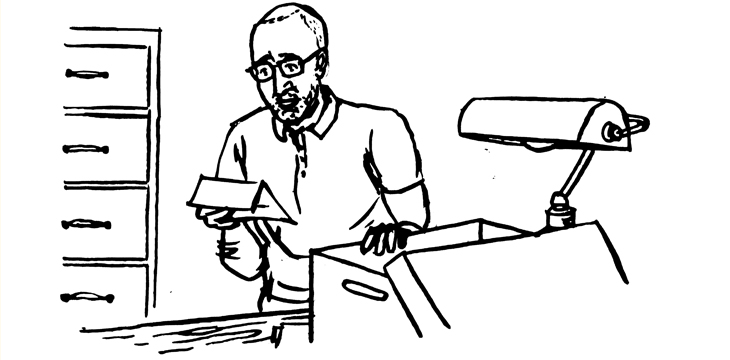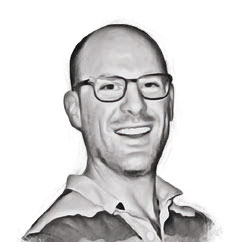The Secret of the Lost Time Capsule
CHAPTER I
Records for Future Ages
 Letters uncovered in UI Special Collections revealed a project that seemed absurdly ambitious.
Letters uncovered in UI Special Collections revealed a project that seemed absurdly ambitious.
I was hunkered down with a box of records in UI Libraries' Special Collections one day in 2015 when an enigmatic folder caught my eye. With an hour to go until class, I had just enough time to look at the intriguing cache of papers inside, labeled "The Far-Reaching Foundation Toward Safer Civilization." Opening it proved a fortuitous decision.
Inside, I found numerous letters and pamphlets from the 1930s written by Duren Ward, a Unitarian minister and former lecturer at the university. Sent to the renowned UI political scientist and historian Benjamin Shambaugh (1892BPh, 1893MA), they detailed Ward's plans to preserve what he described as "Records for Future Ages." Little did I know this archival clue would send me on a long and vexed academic quest ending 800 miles away at the foot of the Rocky Mountains, where a dark tomb holding an even darker piece of history awaited.
The letters revealed a project that seemed absurdly ambitious. Ward told Shambaugh that he planned to gather thousands of books and documents testifying to all aspects of modern civilization, from "machinery and inventions" to "dress and sleeping methods" and "amusements and entertainments." He would then seal the collection until the year 4000, with advance viewings every two centuries and instructions to reseal it for subsequent millennia. Ward called it "a megaphone salute to the far-away future."
Little did I know this archival clue would send me on a long and vexed academic quest ending 800 miles away at the foot of the Rocky Mountains, where a dark tomb holding an even darker piece of history awaited.
In other words, it was a time capsule—which happens to be one of my areas of expertise.
As a UI history professor researching a book about the invention of the time capsule in the Gilded Age and Progressive Era, I had spent hours in archives nationwide poring over the contents of all kinds of chests and safes that had been locked for 100 years. These collections, which I have occasionally shared with UI students in courses such as "History of the Future" and "A History of Time in America," can tell us a lot about how various communities viewed their present and their duties to posterity. They also reveal what events, artifacts, or lives people deemed worthy of preserving for future historians, thus shedding light on the politics of memory.
But Ward's time capsule project—the secrets to which were right in front of me in our own university library—stood out. Scholars have assumed that no one had tried to encapsulate an entire civilization or to span millennia until 1939, when Westinghouse buried its missile-shaped time capsule at the New York World's Fair with an opening date of 6939. Was the idea of a long-range time capsule in fact conceived decades earlier at the UI?
As I plowed through the archival folder, further questions arose: What were Ward's reasons for undertaking such a vast project? Did he fulfill his plan? If so, are his Records for Future Ages still out there and on course for their destination? A preliminary Google search came back empty, but fortunately Ward's letters began to provide some answers. They also revealed his disturbing views on government, race, and the future of civilization.
CHAPTER II
A Man Gripped by Obsession
 Ward left Iowa City for Denver to accumulate his records in what he considered "the safest place in America."
Ward left Iowa City for Denver to accumulate his records in what he considered "the safest place in America."
Ward explained to Shambaugh that the idea had come to him more than 30 years earlier. He had just moved to Iowa City in 1899 to serve as pastor of the All Souls' Unitarian Church, which many professors, including Shambaugh, attended. Ward possessed a doctorate and moonlighted as a lecturer in the university's anthropology department and as secretary for the local chapter of the Iowa Anthropological Association. Striving for a fresh angle on the social and ethical questions of his time, Ward had an epiphany: He would consider them from the perspective of the distant future. Before long, he had drafted 42 letters, each addressed to different future centuries.
The epiphany may have been sparked by Ward's experience as an anthropologist and archaeologist in Iowa (scholars still draw on his studies of the Meskwaki Indians). The archaeological evidence of earlier periods and cultures, he complained, is painfully limited. "What previous centuries have passed on to us has been nine-tenths accident," Ward wrote. Not even the Greeks or Romans "left an intended, purposive planned record (other than a tomb inscription) for any later ages." And the pharaohs built their pyramids for the sake of "royal honor and certain salvation in some hazy after-death existence," he noted, rather than to enlighten future historians about their people's beliefs or way of life. Correcting this oversight (and, he believed, demonstrating Anglo-Saxons' greater foresight), Ward would produce an objective synopsis of contemporary civilization, including "our mistakes, our errors, our blunders."
Fears that civilization was about to collapse lent urgency to the project. Ward confessed to Shambaugh that he had felt a "sad uneasiness regarding the prospects of humanity" since adolescence. Those doubts were now exacerbated by the Great Depression and by the looming threat of a second world war. He worried that the collapse of modern civilization, given its complexities and capacities, would be a "far greater calamity than that of any ancient fall. … The total human loss would be beyond description." And he believed it would be followed by a "longer stage of Dark Ages and Barbarism." In that event, Ward thought his storehouse of scientific knowledge would prove indispensable, just as doomsday preppers today put stock in survival manuals.
But Ward ultimately retained hope of averting that calamity. This could only be done, he believed, by scientifically studying the history of civilizations and distinguishing those conditions that favor progress from those that lead to decline. His own time capsules—under the supervision of his Far-Reaching Foundation Toward Safer Civilization—would provide the crucial "data" to allow future societies to diagnose these patterns of progress and decline. With these periodic check-ups, he reassured Shambaugh, the "scientific method" would endure.
Ward's letters, furthermore, reveal a man gripped by an obsession with the fame and recognition he might garner in coming centuries.
Ward's faith in science had a dark side, however. He was a fervent advocate of the technocracy movement, which was then attracting legions of gray-uniformed supporters to its grim vision of a post-democratic future of social engineering. They believed that scientists and engineers should not be confined to their specialized roles but should replace politicians and take control of society and the state.
Even more troubling, Ward wanted—like many other technocrats—to apply social engineering to human reproduction. As a eugenicist, he urged involuntary sterilization to prevent the "unfit" from "swamping improvement," as he described it. Writing to the future offered him a means to indulge his fantasy: "Within two generations, society will not allow the lascivious, the passionate, the uncontrolled to reproduce," saving itself from "absolute destruction."
Ward saw eugenics ultimately as a means to implement his racist and anti-immigrant views, which he expressed in an unpublished manuscript titled Making America Thorobred. These prejudices were reflected in his Records for Future Ages. Whereas earlier time capsules welcomed contributions from immigrants and, in some cases, African Americans, he announced that his was to focus on "our Anglo-Saxon People specially."
Ward's letters, furthermore, reveal a man gripped by an obsession with the fame and recognition he might garner in coming centuries. All time capsules appeal to our desire to transcend death. But Ward's fear of death—which psychologists termed "thanatophobia"—was particularly pronounced. He admitted to Shambaugh that his mortality "has rested very heavily upon my mind for half a century" and that the "anxious strain" to exert a posthumous influence was a motivation for his time-capsule scheme.
Ward attempted to recruit Shambaugh by playing on his own longings for immortality. "Try, if you will," he urged his former colleague, "to realize the memory status of any professor in the Iowa University who died forty or fifty years ago. ... Their names and labors have already well-nigh sunk into oblivion. They will hereafter be known only to some plodding historian. ... And what of the pitiable forgottenless condition of the millions in Iowa or elsewhere?" By contrast, thousands of people would come to visit the Records to Future Ages and see the contributors' names engraved there. Interest in them would "increase ... with every decade and every century" until A.D. 4000, when news of the unsealing would be "flash[ed] to earth's remotest nook."
It's unknown what Shambaugh thought of Ward's idea. As is so common with correspondence in archival collections, we only hear one side of the conversation.
CHAPTER III
Palaces for the Dead
 Ward stored the documents in "Palaces for the Dead," mausoleums
made with earthquake-proof reinforced concrete.
Ward stored the documents in "Palaces for the Dead," mausoleums
made with earthquake-proof reinforced concrete.
With considerable misgivings—about fulfilling Ward's hopes for posthumous glory and rescuing his noxious writings from oblivion—I undertook to locate his time capsule. In 1908, Ward left Iowa City for a pastorship in Denver, and it was there—"the safest place in America," he claimed, vulnerable only to "war or earthquake"—that he began accumulating his records in the late 1920s. He decided not to entrust them to an existing institution; even universities will not last more than two or three centuries, he wrote, "for they depend upon the maintenance of an exceedingly high degree of education and culture, and the continuity of political arrangements." He also rejected the idea of interring them in some ordinary building, which he believed would likely be demolished "within 100 years."
Ward found an unusual solution in the form of two Colorado mausoleums. To cater to Americans' growing squeamishness about bodily decomposition, these multi-vault "Palaces for the Dead" had recently been built as high-rise structures with walls of fire- and earthquake-proof reinforced concrete, faced with "time-defying" granite and equipped with special "desiccating systems" of heating and ventilation. Perfect, in other words, for storing fragile books and documents. Ward purchased two family rooms at reduced rate, with a perpetual-care contract guaranteeing upkeep through the ages, and started stocking them with airtight, copper boxes full of his cellophane-wrapped treasures.
The task was so monumental, and Ward's resources so limited, that it took another 12 years to complete. Not until March 1940 did Ward declare the job finished. He had dedicated half of his life and most of his savings to it. The strain of laboring 10 hours a day may have exacerbated his blindness. Within another 10 months, he was dead.
Ward's letters, along with additional materials he left to the Iowa City branch of the State Historical Society of Iowa, enabled me to track down the two cemeteries in suburban Denver. Their managers seemed suspicious of my email inquiries. "What is your relationship to this compartment and the family there?" one of them responded. Neither of them appeared to know about the unusual hoard in their midst. It was not even mentioned in Colorado Public Radio's "Five Fascinating Facts about Denver's Fairmount Cemetery." Once I had assured them of my good intentions and convinced my family that this would be a fun detour from our upcoming vacation in the Rockies, we flew out there.
Ward found an unusual solution in the form of two Colorado mausoleums.
Both cemeteries were quiet on the day of our visit. Ward's foundation had ceased to operate by the 1950s, so the crowds of visitors he'd predicted were nowhere to be seen. Even so, the crypts were intact and precisely as Ward had described them. Through the locked bronze-grilled doors, we observed the marble vaults concealing their payload to the distant future, awaiting their first scheduled opening in another 112 years. A stained-glass window depicting mountain scenes and a poetic inscription by Ward cast a hallowed light on one of the chambers. These details were designed to draw attention to the deposit and ensure it was remembered across the centuries.
The survival of these vaults raises thorny questions. Should a plaque be added to warn the capsules' future recipients to remain wary of their contents—that those racial and eugenicist theories lay the foundation for genocide during the Second World War and have since been discredited? Should a new counter-time capsule be added to the crypts containing more progressive ideas and giving voice to those groups that Ward excluded—and if so, how does one go about selecting them? And do we still believe in the possibility of encapsulating an entire nation or civilization?
Alternatively, are Ward's repositories best left alone, so as not to unduly attract the future's attention? In any case, after 20 centuries the leather-bound books—and the knowledge of our alphabet and language needed to read them—may well have withered away. Further increasing the odds of failure, Ward had strangely neglected to include in his plaque instructions about when and how to open the vaults.
Ultimately, I decided it was my duty as a historian and educator to bring the records to light in order to understand what historical forces led people like Ward to espouse such doctrines, and to expose the racist and antidemocratic underpinnings of what was purported to be objective science. To ignore or suppress the findings would be to cherry-pick one's examples, missing an opportunity to learn from the mistakes of the past.

